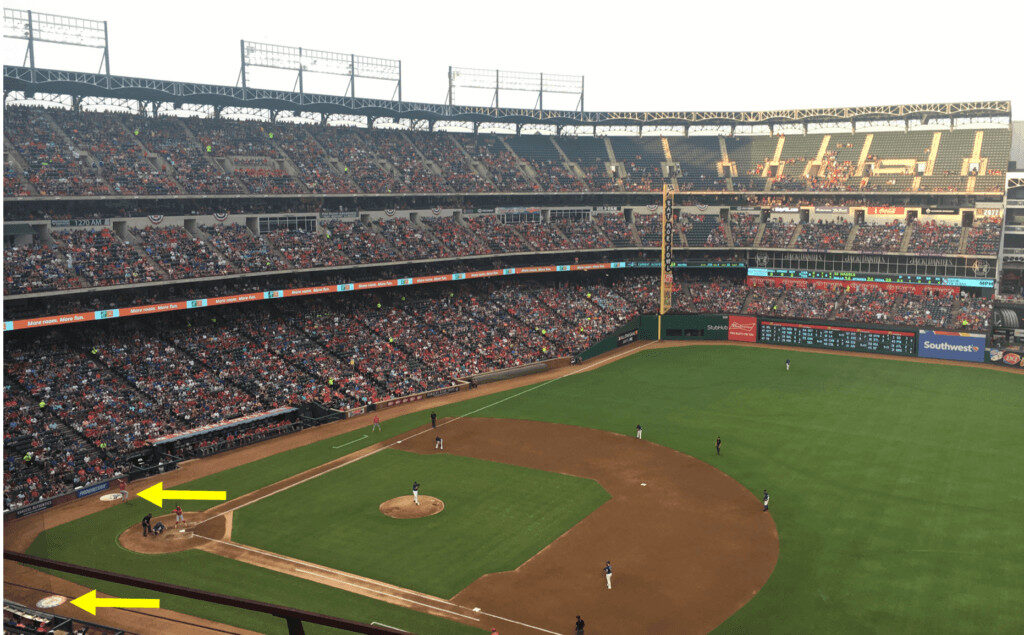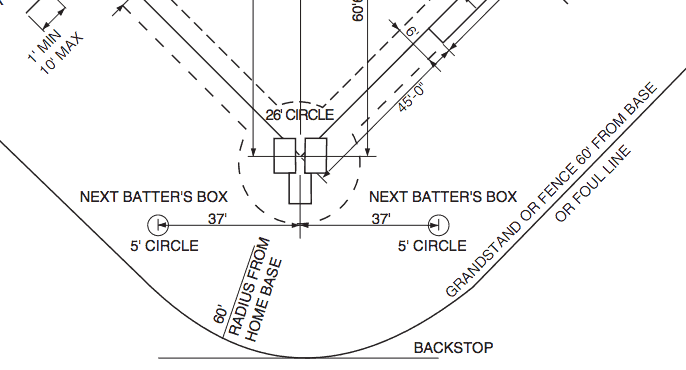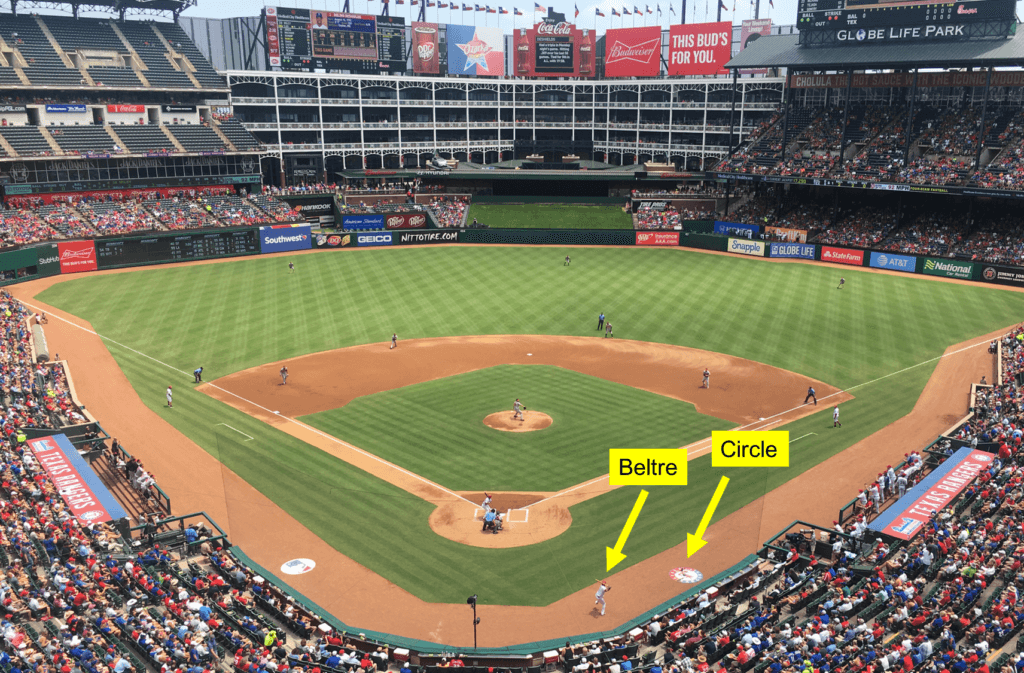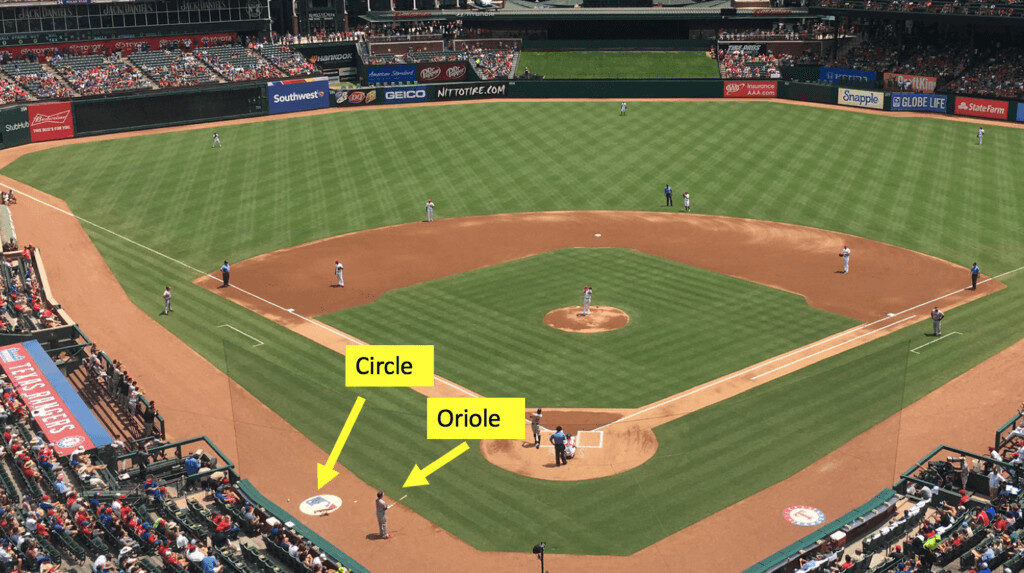Update: See the end of the post with some photos I took at the game yesterday where Beltre got his 3000th career hit – quite a milestone!
Those who study and practice Lean often know about Taiichi Ohno, one of the creators of the Toyota Production System, and his famed “Ohno Circle.” As the stories are told, Ohno would draw a chalk circle on the ground in the factory and tell somebody to stand there and observe.
Mark Rosenthal wroe a good post about this. I parodied the Ohno circle in this April Fools' Day post from 2010 (see “Wii Ohno Circle”):
Today's post is about standing (or not standing) in a different circle… at a Major League Baseball game.
Hat tip to Paul Lukas and Uni-Watch.com (a non-Lean-related blog I read regularly) for an item in this blog post.
Here's a news story about Texas Rangers' third baseman Adrian Beltre getting ejected for doing something the umpire didn't appreciate:
WATCH: Rangers' Beltre gets ejected for moving on-deck circle in blowout loss
As described there:
Late in the stages of the Rangers' 22-10 loss against the Miami Marlins, Beltre was warned by umpire Gerry Davis to get back onto the on-deck circle that he'd strayed from. Beltre, a human adult, responded by dragging the on-deck circle to where he was positioned. Davis, also a human adult, responded to that by ejecting Beltre from the game. Really.
Beltre, a human adult, has been in the major leagues since 1998 and is approaching 3,000 career hits, a milestone that usually guarantees induction into the Hall of Fame.
For those who don't know baseball, the “on-deck circle” is an area where the next batter up generally stands, stretches, and takes practice swings. This location is usually marked in one way or another. It might remind you of 5S: a place for everything, and every batter in his place?
Some batters like to move closer to be more behind home plate instead of to the side… usually the accusation is they are trying to get a better view of the pitcher as they pitch to the previous batter… that's a different form of preparation for their at bat.
A photo from Wikpedia… showing a circle sitting on the dirt that surrounds the playing field.

By Buffalutheran – Own work, CC0, Link
In workplaces, the 5S methodology often means marking the correct location for an item, or it marks the home location of where it goes when not in use. This might mean organizing the drawers in a Japanese hospital in a way that makes it easier to find medications in an emergency. Or, it sometimes, sadly, means a bunch of overkill that just upsets people in a “Lean Office” context.
In my photo from Globe Life Park, below, I've added arrows pointing to the on-deck circles.

A video posted on Twitter, now removed, showed Beltre taking some warm up swings… not standing in the circle:
As the TV announcer said:
“Beltre was asked to not hang out behind the plate during the at bat”
Here is a GIF, via Twitter, that shows Beltre moving the on-deck circle… and the umpire then makes the “ejected” motion:
Another view:
This photo shows how far Beltre dragged the circle:
This article has some comments from Beltre:
Rangers' Adrian Beltre on bizarre on-deck circle ejection: ‘I did what he told me'
Beltre played the “safety first” card, basically… and the “it's never been a problem before” card:
“I don't really know,” he said. “The home-plate umpire told me Gerry wanted me to move. I said, ‘Why? I don't want to get hit. I stand here every day, I've been standing here for a lot of years and I've been standing here when he was umpiring home plate and he didn't say nothing. Everybody stands in the same spot. Why do I have to move? I don't want to get hit.'
Here's a GIF showing a player almost being hit by a foul ball while standing in that circle:

Beltre really doesn't want to get hit (just as he famously doesn't like having his head touched):
“Then the second umpire came down and he told me I need to move. I told Gerry – I have no problem but I don't want to get hit. I've been hit when I stand over there. He said, ‘Well I don't' care. You need to be on top of the mat.' So I pulled the mat where I was at and he threw me out.
If the instruction was “You need to be on top of the mat,” then I guess moving the mat is one way to comply with that instruction from the umpire!
But, he got ejected for his initiative and creativity.
Beltre then played the “everybody does it” card:
“If you see the video, you see everybody standing in the same spot. Why was that a problem today? I've been standing in the same spot the whole series.”
What's the Standardized Work?
What does the official policy, the MLB rulebook say? I guess the rulebook shows what the “standardized work” would be, in Lean terms:
The size and location of the on-deck circles is specified:

I don't know for a fact that the Rangers had the on-deck circles in that precise location, 37 feet from the center of home plate. But, let's assume they did (that would be a good question for a reporter to ask).
The only text reference to a rule about the circle is about moving from there to the batter's box in a timely manner, since baseball is concerned about the length of games, as I blogged about earlier this year.
Rule 6.02(d) Comment: Umpires shall encourage the on-deck batter to take a position in the batter's box quickly after the previous batter reaches base or is put out.
The rules do state that each umpire can, basically, make rulings on things not covered in the rules, ejecting a player, it seems, whenever they want (other than being questioned about it).
Each umpire has authority to rule on any point not specifically covered in these rules. (d) Each umpire has authority to disqualify any player, coach, manager or substitute for objecting to decisions or for unsportsmanlike conduct or language, and to eject such disqualified person from the playing field. If an umpire disqualifies a player while a play is in progress, the disqualification shall not take effect until no further action is possible in that play.
Umpire Gerry Davis probably decided that Beltre was being “unsportsmanlike.”
As it says here:
MLB did not comment on the report but said in a statement that “we expect both Club personnel and our Umpires to remain professional on the field at all times”
Parallels to the Workplace
Do we see parallels to hospitals or other workplaces?
Are there rules that routinely get violated that managers don't notice or don't worry about… until they do?
Do employees feel picked on or treated unfairly when they are punished for something that “everybody does?”
If a rule or standard is important, shouldn't it be enforced all the time?
What are your stories about this?
Update: The Ballpark Gemba
Sunday, I had the chance to attend the Rangers' game thanks to a friend who had access to a suite. Sweet!
Here is a photo that shows where Beltre was taking his warmup swings compared to the location of the on-deck circle.

Beltre was, of course, not confronted by the umpire during this game.
Beltre was absolutely correct in his comments that NOBODY stands on the circle. Here's a photo of an Orioles' batter:

I can understand why a player wouldn't want to stand on a vinyl circle. It's much better traction to stand on the dirt or the grass when wearing spikes. Maybe MLB should either:
- Return to simple chalk circles on the dirt, from a simpler time (see photo)
- Draw a line, like a base coach box or a batters box, showing where they can stand (not that the coaches stay within the lines either, as I blogged about).

There's also a safety argument to be made for other players, since the vinyl circles are in play, even being in foul territory.
The Orioles returned to chalk circles at their ballpark, Camden Yards, after their catcher, Caleb Joseph, slipped and fell when chasing a foul ball. There is certainly a risk of injury:
Thankfully, Beltre didn't get ejected, because he collected the 3000th base hit of his career, as I captured here:
And here is a photo of some congratulatory signage:

Here are Beltre's career stats. It was great to see history, as he's only the 31st player in MLB history to reach that milestone. And, he might have done that a game earlier had he not been ejected from the earlier game. I should be thanking that umpire, ha ha.
Please scroll down (or click) to post a comment. Connect with me on LinkedIn.
Let’s work together to build a culture of continuous improvement and psychological safety. If you're a leader looking to create lasting change—not just projects—I help organizations:
- Engage people at all levels in sustainable improvement
- Shift from fear of mistakes to learning from them
- Apply Lean thinking in practical, people-centered ways
Interested in coaching or a keynote talk? Let’s start a conversation.









